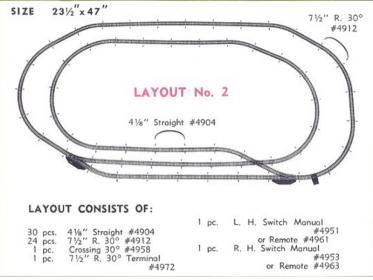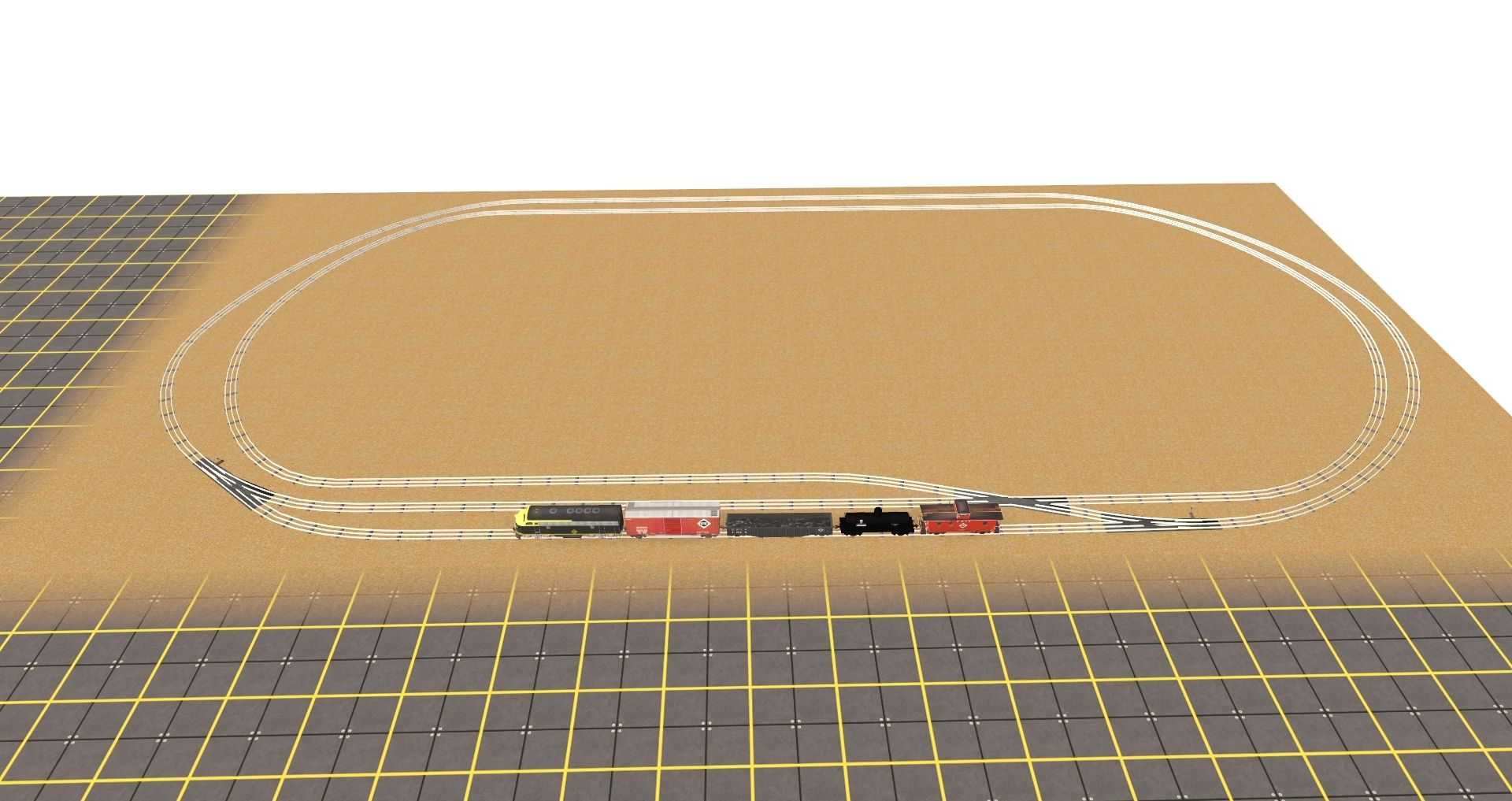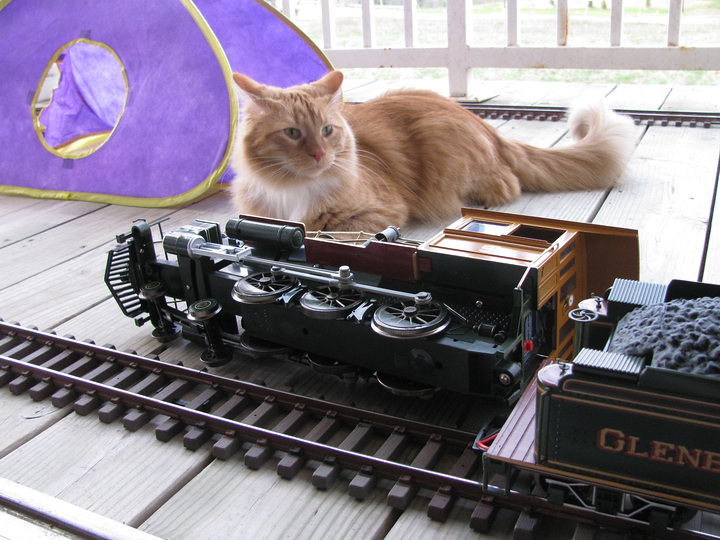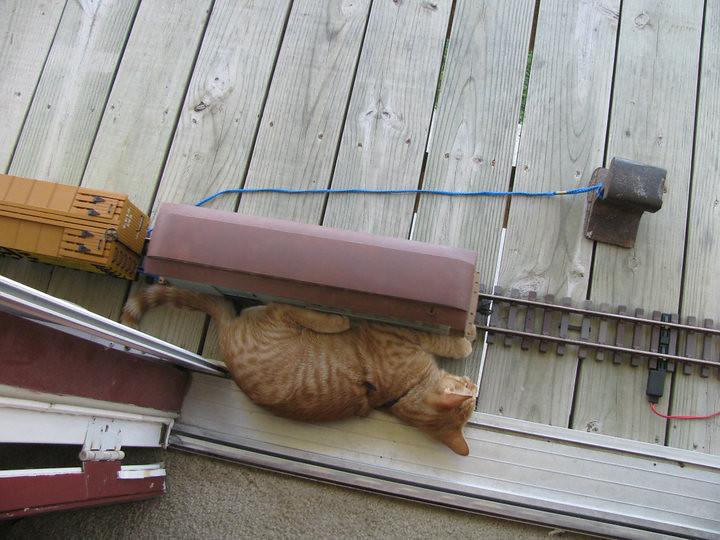I decided to work on a model railroad route. This will be my third attempt at one. Like a lot of routes we build, we start them and for some reason they end up in the bin. These like the others end up in the virtual scrap bin and never see the light of day. This particular route, however, came about on Thursday as part of the single-board challenge for the Multiplayer Surveyor Beta. NJP setup a route for us to build on. He wants us to build as much as we can on a single baseboard. For the "challenge", I decided to build my very first model railroad. With that multiplayer being beta, and the routes not downloadable yet, I decided to build this for real in TRS2019 (plus). The reasons are two-fold. First because I want to add in another baseboard and build it to its correct shape, and also the asset types is really limited still in the multiplayer and I want to add in assets that look similar to what I remember on the layout.
When I was 7, my grandfather gave me an Aurora/Revell N-Gauge Postage Stamp trainset for Christmas in 1968. This was in the early days of N-scale and the early entry into the US market. The set consisted of a simple twice around loop with a couple of switches and a crossover, a powerpack, and a small consist consisting of an Pennsylvania F7 diesel (marketed as an F9), B&M boxcar, Southern gondola, an ATSF flatcar, and a matching Pennsy caboose. We setup everything on the living room rug and ran it a few times, but being N-scale and quite fragile, my dad decided it wasn't a good idea and went about building me a layout.

The initial layout was built as is and placed on a simple piece of 2ft x 4ft plywood. Dad got fancy and put in two bridges just to the right of the curves in the upper left corner. As time went on, the layout changed a bit and he took the original layout shown here, and expanded it slightly. If I can find my original service manual and catalog because he drew on the plan what his changes were, it would easy to illustrate the changes he made to the layout, but without it I'll have to explain it. Starting at the front, the middle track that crosses and forms the inner spiral was lengthened just a bit to the right by a track segment. The bend that connects to the crossover was replaced with a switch, and a line was connected to form a short passing loop on the inside track.
This basic layout became my layout, and shortly after the track plan changed, he raised the back edge to form a slight rise (more about this later). He then used the "Hells Gate Bridge" kit on the upper track, and one of the Warren Truss approach bridges as the bridge for the inner loop. Where the Layout No. 2 is shown, was a small lake that hosted a few rowboats and a small dock.
In the front, just above the third track at the top, was a passenger station. This was a big "modern" station with a cafe, and leading to the left was a short lane with 4 houses - two complete cottages and two houses under construction. Also included was that given and always ubiquitous tunnel over the two tracks in the left corner.
Now this layout, as built, could never be expanded beyond its 2ft x 4ft dimensions. Remember I mentioned the slight rise? The reason for the ever so slight rise and size was due to some height limitations. This layout was meant to fit under my bed and had to clear the sideboard on the frame. To bring the layout out, it sat on some very squeaky grey-colored castor wheels. I can still hear them today, and when I hear something similar I have flashbacks to this layout. The layout was kept fairly clean, but still it was not perfect and the cleaning was a big part of the layout back then with it under the bed and close to the floor.
This layout when completed contained a number of custom scratch-built objects. Being a graphic and fine artist, he constructed some beautiful objects of which I still have today tucked away. One of these is a water tower constructed out of cardstock and balsa wood. If I can find it, I will post pictures of it. That object alone is a show piece. He also made some billboards out of balsa, cardstock, and pictures from magazines. Since he worked in the graphics industry for a production house, he made use of their photostat equipment and made some billboards by scaling down the images clipped from various magazines and fitting them into some green painted frames. To complete the frames, he put some cloth mesh on the bottom part to represent the lattice found on the various billboards in their day.
Over the years I eventually received the Lil Donkey steam locomotive, an ATSF diesel and dummy (my brother had the dummy unit), a couple of passenger cars, and a Rivarossi/Atlas Indiana Harbor Belt steam locomotive. The steam engine died much like a lot of them from that era I found out much later.
The layout lasted until 1975 when it was disassembled and the parts distributed to another much bigger layout and further on to other layouts. Today all this is packed in a plastic crate, along with my other model railroad stuff I had when I gave up the physical hobby in 2004.
Anyway as I started working on the route on Thursday, and more so today as I searched online for the plan shown above, I found myself remembering various good and bad times, my grandfather, and so many other things I forgot about in the 53 years since this layout was first built.
Here's the a website and catalog from Aurora.
http://davidksmith.com/postage-stamp-trains/index.htm
http://davidksmith.com/postage-stamp-trains/service_manual-2.htm
Take a look at the prices! You could pick up a decent running diesel for $12.50.
When I was 7, my grandfather gave me an Aurora/Revell N-Gauge Postage Stamp trainset for Christmas in 1968. This was in the early days of N-scale and the early entry into the US market. The set consisted of a simple twice around loop with a couple of switches and a crossover, a powerpack, and a small consist consisting of an Pennsylvania F7 diesel (marketed as an F9), B&M boxcar, Southern gondola, an ATSF flatcar, and a matching Pennsy caboose. We setup everything on the living room rug and ran it a few times, but being N-scale and quite fragile, my dad decided it wasn't a good idea and went about building me a layout.
The initial layout was built as is and placed on a simple piece of 2ft x 4ft plywood. Dad got fancy and put in two bridges just to the right of the curves in the upper left corner. As time went on, the layout changed a bit and he took the original layout shown here, and expanded it slightly. If I can find my original service manual and catalog because he drew on the plan what his changes were, it would easy to illustrate the changes he made to the layout, but without it I'll have to explain it. Starting at the front, the middle track that crosses and forms the inner spiral was lengthened just a bit to the right by a track segment. The bend that connects to the crossover was replaced with a switch, and a line was connected to form a short passing loop on the inside track.
This basic layout became my layout, and shortly after the track plan changed, he raised the back edge to form a slight rise (more about this later). He then used the "Hells Gate Bridge" kit on the upper track, and one of the Warren Truss approach bridges as the bridge for the inner loop. Where the Layout No. 2 is shown, was a small lake that hosted a few rowboats and a small dock.
In the front, just above the third track at the top, was a passenger station. This was a big "modern" station with a cafe, and leading to the left was a short lane with 4 houses - two complete cottages and two houses under construction. Also included was that given and always ubiquitous tunnel over the two tracks in the left corner.
Now this layout, as built, could never be expanded beyond its 2ft x 4ft dimensions. Remember I mentioned the slight rise? The reason for the ever so slight rise and size was due to some height limitations. This layout was meant to fit under my bed and had to clear the sideboard on the frame. To bring the layout out, it sat on some very squeaky grey-colored castor wheels. I can still hear them today, and when I hear something similar I have flashbacks to this layout. The layout was kept fairly clean, but still it was not perfect and the cleaning was a big part of the layout back then with it under the bed and close to the floor.
This layout when completed contained a number of custom scratch-built objects. Being a graphic and fine artist, he constructed some beautiful objects of which I still have today tucked away. One of these is a water tower constructed out of cardstock and balsa wood. If I can find it, I will post pictures of it. That object alone is a show piece. He also made some billboards out of balsa, cardstock, and pictures from magazines. Since he worked in the graphics industry for a production house, he made use of their photostat equipment and made some billboards by scaling down the images clipped from various magazines and fitting them into some green painted frames. To complete the frames, he put some cloth mesh on the bottom part to represent the lattice found on the various billboards in their day.
Over the years I eventually received the Lil Donkey steam locomotive, an ATSF diesel and dummy (my brother had the dummy unit), a couple of passenger cars, and a Rivarossi/Atlas Indiana Harbor Belt steam locomotive. The steam engine died much like a lot of them from that era I found out much later.
The layout lasted until 1975 when it was disassembled and the parts distributed to another much bigger layout and further on to other layouts. Today all this is packed in a plastic crate, along with my other model railroad stuff I had when I gave up the physical hobby in 2004.
Anyway as I started working on the route on Thursday, and more so today as I searched online for the plan shown above, I found myself remembering various good and bad times, my grandfather, and so many other things I forgot about in the 53 years since this layout was first built.
Here's the a website and catalog from Aurora.
http://davidksmith.com/postage-stamp-trains/index.htm
http://davidksmith.com/postage-stamp-trains/service_manual-2.htm
Take a look at the prices! You could pick up a decent running diesel for $12.50.







